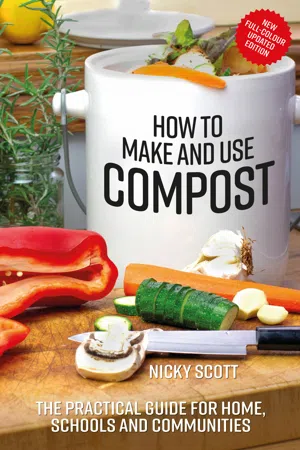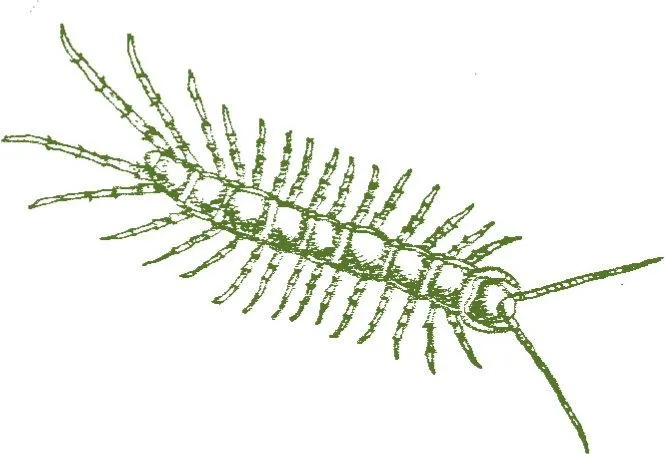
eBook - ePub
How to Make and Use Compost
The practical guide for home, schools and communities
- 200 pages
- English
- ePUB (mobile friendly)
- Available on iOS & Android
eBook - ePub
About this book
The ultimate guide to composting. Find out how to compost in different ways for the home or community, what to compost and why it is such a good idea.
Frequently asked questions
Yes, you can cancel anytime from the Subscription tab in your account settings on the Perlego website. Your subscription will stay active until the end of your current billing period. Learn how to cancel your subscription.
At the moment all of our mobile-responsive ePub books are available to download via the app. Most of our PDFs are also available to download and we're working on making the final remaining ones downloadable now. Learn more here.
Perlego offers two plans: Essential and Complete
- Essential is ideal for learners and professionals who enjoy exploring a wide range of subjects. Access the Essential Library with 800,000+ trusted titles and best-sellers across business, personal growth, and the humanities. Includes unlimited reading time and Standard Read Aloud voice.
- Complete: Perfect for advanced learners and researchers needing full, unrestricted access. Unlock 1.4M+ books across hundreds of subjects, including academic and specialized titles. The Complete Plan also includes advanced features like Premium Read Aloud and Research Assistant.
We are an online textbook subscription service, where you can get access to an entire online library for less than the price of a single book per month. With over 1 million books across 1000+ topics, we’ve got you covered! Learn more here.
Look out for the read-aloud symbol on your next book to see if you can listen to it. The read-aloud tool reads text aloud for you, highlighting the text as it is being read. You can pause it, speed it up and slow it down. Learn more here.
Yes! You can use the Perlego app on both iOS or Android devices to read anytime, anywhere — even offline. Perfect for commutes or when you’re on the go.
Please note we cannot support devices running on iOS 13 and Android 7 or earlier. Learn more about using the app.
Please note we cannot support devices running on iOS 13 and Android 7 or earlier. Learn more about using the app.
Yes, you can access How to Make and Use Compost by Nicky Scott in PDF and/or ePUB format, as well as other popular books in Ciencias biológicas & Horticultura. We have over one million books available in our catalogue for you to explore.
Information
12

Credit: Amanda Cuthbert
14
CHAPTER 1
WHY MAKE COMPOST?

“Why would you want to deny the Earth your cauliflower stalk?” – Satish Kumar
At the end of a meal, many leftovers go straight into the bin along with any peelings, etc. from preparing the food. We currently throw away a third of the food we buy, but the tide is turning and more and more people want to grow their own food in healthy soil, and reduce their waste, which is why making compost is so important.
Whatever type of soil you have, compost will improve it. I’ve heard people talk about how compost is only a ‘soil conditioner’, as though somehow this was not really important. I think they mean that compost does not add much in the way of nutrients to the soil, but this is not the point. Soil conditioning really means adding humus to the soil. Humus is stable organic matter in the soil and it acts like ‘glue’, holding on to nutrients and water. In effect humus adds life back to the soil: doing this is the most important thing that we can do for the soil and it’s ridiculously easy.
Compost has some nutrient value too, mostly held by the microbes that have proliferated during the composting process. The following are just some of the benefits of adding compost to your soil.
Healthy soil
Compost feeds your soil, which feeds your plants.
Compost adds life in the form of microorganisms
Using compost on your soil will dramatically increase the amount of life in that soil – both life that is visible to the naked eye and, more importantly, life that can be seen only through a microscope. The addition of compost builds a healthy soil and so boosts the microbial activity, which provides food for hundreds of thousands of different 15species of fungi, bacteria and other organisms; these microorganisms are also food for a whole range of other organisms, which in turn are fed off by predators. What we can see when we look at compost are the creatures, mini-beasts on the macro scale; you will need a magnifying glass to see the very small ones, but many are obvious and well known to us. See ‘More wildlife’, page 18, for more on this.
The soil microbes feed your plants and protect them from pests and diseases.
Crucially, this microscopic world is cycling nutrients from the compost materials into a form that the plants in our gardens can easily assimilate, and holding them in the soil until the plants need them. Of all the soil organisms the worm is the one that we all recognize as invaluable for creating a healthy soil, and it does indeed possess almost miraculous powers – both the compost-dwelling species and the larger soil dwellers – but in fact it is the whole complex web of life in the soil that is kept vibrant by regular additions of compost.
There are over 600 million beneficial bacteria in just one gram of healthy soil (about a level teaspoonful).
Compost changes the physical structure of the soil
The humus that remains when compost has been further broken down in the soil coats the soil particles and creates the crumb structure that allows the exchange of gases and liquids. So in sandy soils compost increases not only the water-holding capacity but also the nutrient-holding capacity of the soil. In clay soils it flocculates the clay particles – it gathers the minute particles of clay together, again into a crumb texture.
Compost buffers the soil pH
Compost ‘buffers’ the extremes of acidity and alkalinity in a soil.
Healthy, humus-rich soils ‘buffer’ the extremes of acidity and alkalinity – humus doesn’t actually change the pH, but it enables plants to grow that would otherwise be intolerant of the degree of alkalinity or acidity of your soil.16
Compost adds air
Compost opens up clay soils.
Compost helps open up clay soils and compacted soils, enabling them to breathe. Soils that cannot breathe become anaerobic (without air), and without air organic matter in the soil can ferment, with anaerobic microorganisms producing all kinds of by-products toxic to plants, such as alcohol.
Compost reduces the need to water
Compost (and humus) improves the water-holding capacity of free-draining sandy soils.
In free-draining soils, compost holds moisture. If soils cannot hold water then plants wither and die, so increasing the water-holding capacity of soil is a fundamental and dramatic advantage. When the compost has finally been broken down by the life in the soil, a fraction of stable carbon remains as colloidal particles (i.e. humus), which hold on to water molecules.
Less need for fertilizers
The tiny colloidal particles of humus create a wide surface area in the soil, which holds on to nutrients which would otherwise be washed into the subsoil, beyond the reach of the plants’ roots.
The soil is alive with networks of plant roots and fungal strands far thinner than a human hair and impossible to detect without a powerful microscope. The composting process takes everything apart down to a molecular level, which is then rebuilt into other forms of life. Tiny particles of compost have an electrical charge which holds onto water and nutrients. Clay soils in particular do this and can be extremely fertile as a result, though they do compact easily and require the addition of compost to add the necessary air.
Most plants growing in a healthy soil form symbiotic associations with the soil mycorrhizal fungi. These fungi take compounds exuded by the plant, and in 17exchange the plant takes minerals and nutrients from the fungi. Some plants also form associations with bacteria: the most well known of these are the azobacters, which help leguminous plants take up nitrogen.
The micro flora and fauna in the soil also hold on to and cycle nutrients around the plants’ roots, helping to build the soil ecosystem.
Conversely, adding chemical fertilize...
Table of contents
- Title Page
- Dedication
- Contents
- Acknowledgements
- Introduction
- Part I
- Part II
- Part III
- Resources
- Index
- Also from Green Books
- Copyright